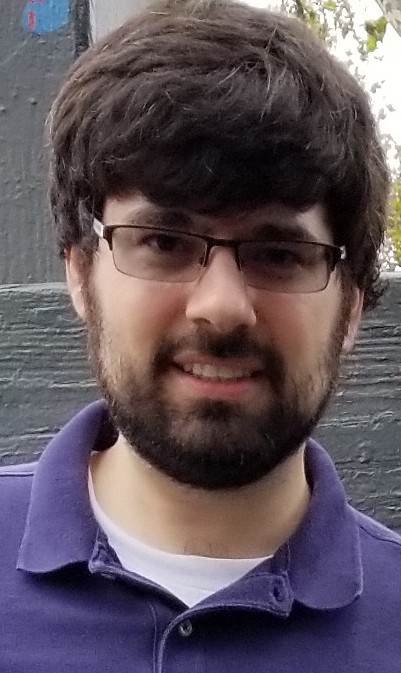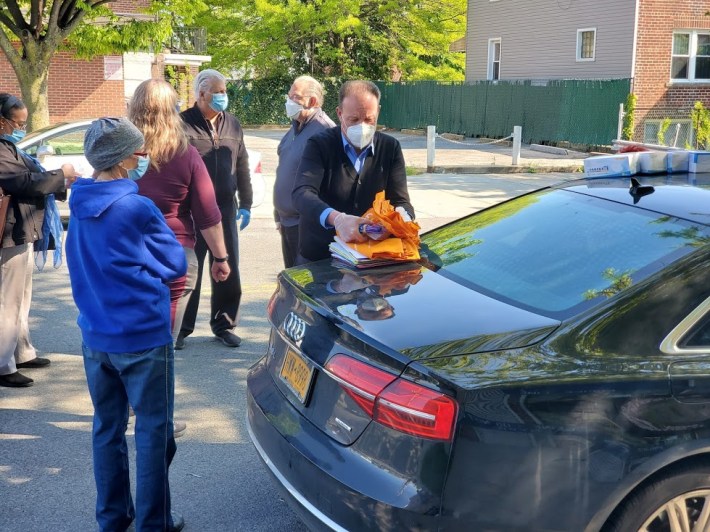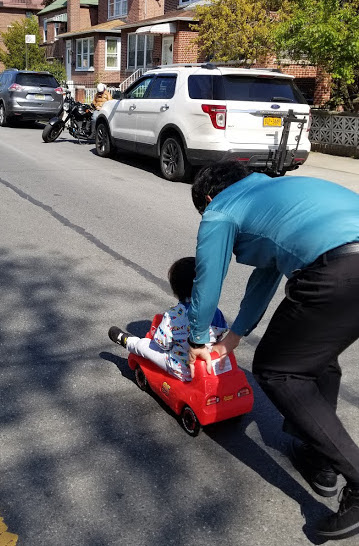
On May 13, the mayor’s press conference had the best news I didn’t expect to hear: Rhinelander Avenue in Morris Park would be receiving an open street.
On May 14, my neighbors rallied to try to close it back up so ... cars.
First, the good news: From the second the police barricades were set up on the half-mile span between Bronxdale Avenue and Williamsbridge Road — the heart of Morris Park — I was out there with my 2-year old. Our lives are COVID typical: Stuck inside. But I can’t keep inside indefinitely, and he needs more space than our small yard provides. Having this open street just steps away is an absolute good.
He doesn't know the politics. But he knows how to have fun. When we got outside, he reveled in the space — enough to ride his little toy scooter. He likes to go fast, but we observed the 5 mph "shared street" limit, of course.
Rhinelander Avenue is considered a “Local Precinct Street” in the mayor's parlance, but once the barriers were deployed, no police officers were on hand, which is great because open streets don’t require the intense police resources that sunk the mayor's initial open street pilot.
Within two hours, Council Member Mark Gjonaj drove into the street with his car. But Gjonaj, who has opposed street safety and transit projects before, didn’t come to celebrate the new open space. No, he came armed with a single-question survey printed just for the occasion.

Talk about a rush to judgment! Gjonaj's survey — check one column, “I approve the open streets program on Rhinelander Ave.” or the other, "I oppose the open streets program on Rhinelander Ave.” — was being conducted even before the neighborhood could come to appreciate the change. It was a cynical bid to rally opposition before the play street could become popular.
“I’ll do the bidding of the will of the people,” said Gjonaj, who also claimed to be carrying out the will of his constituents when he tried unsuccessfully to block a road diet safety redesign of Morris Park Avenue that, statistics show, would save lives and not disrupt traffic flow (as long as drivers don't double-park illegally).
Community Board 11 District Manager Jeremy Warneke posted on Facebook that the DOT's decision to make Rhinelander Avenue an open street actually came from a member of the public. But that wasn’t good enough for Gjonaj.
“One person supported this," he claimed. "One person made all this happen without input from anybody else.”
He used his appearance to generate support for closing the street from my neighbors with closed minds.
“I’m upset they didn’t ask me,” said Bronx Community Board 11 member Yahay Obeid. “Our councilman right there, he’s our leader, he represents us. They could have asked one person — it would have been him.”
If the DOT declined to seek Gjonaj's position, it makes some sense: He likes to portray himself as neutral, simply following the will of the community, but during an April CB11 full board meeting, he made it clear he has no interest in creating space for residents to socially distance themselves during the coronavirus crisis.
“I get a bit upset when we say we’re going to close down roadways, and make them walk-able paths,” Gjonaj said, missing the point of open streets, which are meant to provide more space as parks get increasingly crowded.
.@MarkGjonajNY: “I get a bit upset when we say we’re going to close down parks, we’re going to open... close down roadways, and make them walk-able paths - why not just open up a park?” pic.twitter.com/RM4Gb9bBXw
— Michael Kaess (@WaluigiSoap) May 5, 2020
Community Board 11 Chairman and president of the Morris Park Community Association Al D’Angelo, plus volunteers from the association and the board — the same groups who helped gather signatures for the anti-road diet petition last year — joined Gjonaj to canvas the street.
Gjonaj canvassed from his car, one block at a time! At each block, he’d get out of his vehicle to use his bullhorn to advertise a free mask giveaway, in a ploy to get residents to come out of their homes and participate in his survey.

The objections to the open street are baseless. One woman was worried that it would become crowded with people from outside the neighborhood — something which is easily solvable by introducing more open streets in their respective neighborhoods. Another frantic woman worried about potential liability issues.
"What if someone gets hurt in front of my property? Will they sue me?" she asked, an illogical thought considering that people could more easily be injured in front of her house if the street is filled with fast-moving car traffic, too.
A senior complained about having to move the barriers herself to drive into the block, a minor inconvenience.
There were positive responses as well. Folks who had taken advantage of the open street to walk said they appreciated the increased safety and quiet. Their voices of support were much more coherent relative to the detractors. It’s unclear to me if their votes in support were recorded.
After reaching the end of the open street at Bronxdale Avenue, Gjonaj’s associates tallied up the results of their unscientific survey. They tallied 158 against open streets, and 17 in favor. There’s no doubt Gjonaj will repeatedly refer to these numbers in the days ahead as he tries to kill our open street.
I’m hopeful that health and safety will prevail, and the city continues the open street on Rhinelander Avenue.






